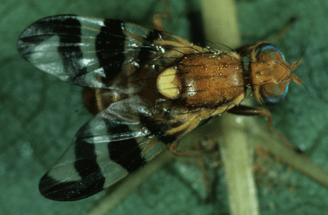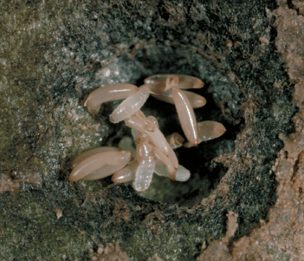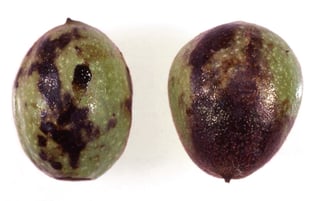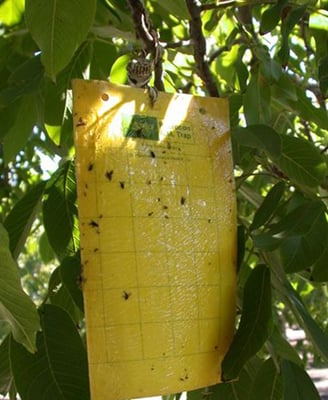Monitoring Walnut Husk Fly Using Traps


Description
The walnut husk fly (WHF) is a brightly colored insect, about the size of a house fly with a pair of wings that have dark bands on them. A striking feature is the yellow spot on its back. The females are different from the males because they have yellow front legs, pointed abdomen and are slightly bigger in size than the male. The males have black front legs.
Walnut husk fly (adult). Photo: Jack Kelly Clark.
Damage
The WHF is a serious insect pest of walnuts in California, attacking all varieties. The infestation begins with the female laying eggs underneath the husk, producing stings. Stings are damaging punctures on the husk that appear as soft, darkened spots. The eggs hatch into larvae called maggots, that live inside and feed on the flesh of the husk, causing more damage. The feeding activity of the maggots release pigment that stains the shell and may change the flavor. In severe cases, the husk sticks to the shell making husk removal difficult. The damage may predispose the kernel to colonization by fungi, thus enhancing risk of contamination by mycotoxin. The stain on the walnut reduces the market value of the crop when sold in shell. Emergence of the adults has been earlier than normal in recent years, thus necessitating earlier planning for implementation of management strategies. Because there is only two week window between adult detection and egg-laying, monitoring is key to its successful control.
How to use traps for weekly monitoring of WHF
Hang traps as high as possible (at least 6 feet from the ground) within an area of dense foliage on the north side of the trees. This will give a correct population count of the WHF in the orchard.
Use at least 2 traps/10 acres. Place the traps in hot spot areas such as trees growing near black walnut trees, trees with history of WHF infestation in the previous season, heavily shaded trees, or trees in damp areas.
Monitor traps 2-3 times a week for good timing of treatment.
Keep record of the WHF caught in the trap.
Monitoring should begin in June in the Central Valley and by mid-May in the coastal areas. Precise timing of sprays based on monitoring should coincide with the trap catches. Adults can be monitored with yellow sticky trap (Pherocon AM) baited with ammonium carbonate to attract the adults. The ammonium carbonate should be replaced every three weeks. Researchers are currently investigating the efficacy of a new pheromone lure for walnut husk fly. Studies are currently underway to determine whether the new pheromone will enhance detection of the adult WHF either alone or in combination with the ammonium carbonate.


Eggs of walnut husk fly. Photo: Jack Kelly Clark.




Walnut damaged by WHF. Photo: R. Van Steenwyk.
How to use trapping information to make management decision
Overall trap catches: when there is low to moderate infestation of WHF on the orchard, spray when there is a sharp increase in trap counts. In the case of high infestation, spray as soon as the flies are detected on the trap. Don’t wait until you observe a sharp increase in trap catches.
Detection of eggs in trapped female: this is to show if the females are carrying eggs, so that they can be killed before they start egg-laying on the husk. Make use of a hand lens to identify females (description given above) in the catches. You can use a pointed object like a pencil to press the abdomen and squeeze out the eggs if present. Eggs resemble small grains of white rice. Apply insecticides when you detect the first female with eggs to minimize damage.
Monitor for stings: This is not the ideal technique to determine the timing of treatment because the presence of stings on the husk show that females have already laid eggs. However, it is practically useful for evaluating the efficacy of your spray application. In this case, inspect at least 10 nuts on the north side of 20 trees for stings and apply insecticide (a combination of ovicidal (egg-killing) property and adulticide).
Yellow sticky trap for monitoring walnut husk fly.
Photo: R. Van Steenwyk.
Continue to monitor traps throughout the season. Post-treatment catches from the traps and presence of fresh stings can be used to determine timing of treatment. Spraying can be done if harvest is more than 3 weeks away. Future research activities would focus on developing new lures that are effective and reliable in trap catches.
For more information on management of walnut husk fly, visit UC IPM Online (www.ipm.ucdavis.edu). You may also access the Walnut Research Reports through the UC Davis Fruit and Nut Information Center website (http://walnutresearch.ucdavis.edu) for detailed information on insecticide efficacy trials. Always read the label of the product being used and note that all registered pesticides are not necessarily listed on the UC IPM Online website (http://www.ipm.ucdavis.edu) or in this newsletter. Always check with certifier to determine which products are organically acceptable.
Selected References
Van Steenwyk, R.A., Zolbrod, S.K., Nomoto, R.M., Fernandez, T.K. 2005. Control of walnut husk fly using reduced risk products. Walnut Research Reports. http://walnutresearch.ucdavis.edu.
UC ANR. 1996. Walnut Husk Fly: Biology, Monitoring, and Control Strategies. Oakland: Univ. Calif. Div. Agric. Nat. Res. Publ. 6567D.
UC IPM Pest Notes. 1996. Walnut husk fly. University of California Statewide Integrated Pest Management Program, Agriculture and Natural Resources Publication 7430.
Acknowledgement: Elizabeth Fichtner, Cooperative Extension Farm Advisor (Kings and Tulare County Counties), for providing technical support.
Disclaimer: Mentioning of any active ingredients or products is not an endorsement or recommendation. All chemicals must be applied following the chemical label, local and federal regulations. Please check with your pest control adviser to confirm rates and site-specific restrictions. The authors are not liable for any damage from use or misuse.
